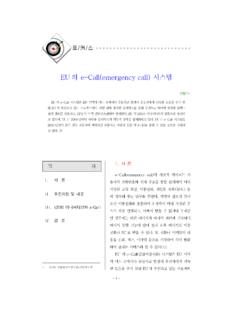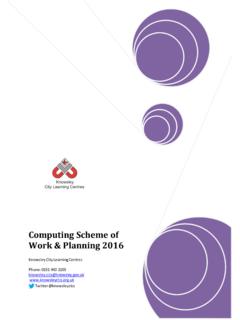Transcription of Automotive HMI: Current status and future …
1 Automotive HMI: Current status and future challenges Major achievements last ten years Advanced display technologies have changed the dashboard layout from a rather static to a more flexible, dynamic and adaptable design Haptic devices have become available, providing new channels to give feedback to the driver. Speech input lower driver's distraction when commanding the vehicle or its options ( navigation devices, radios or mobile phones). Better understanding of human factors ( prioritising of tasks). Major problems, now and in coming ten years Market forces are driving towards increased complexity of the driver's working environment Nomadic devices are increasing safety risks unless integrated Input to round table discussion Andr Vits, European Commission, DG INFSO Automotive HMI: Current status and future challenges Most promising solutions Agreed and implemented design principles according to the European Statement of Principles (ESoP) on HMI.
2 Integration of ADAS requirements into the ESoP. Fostering the discussion between nomadic device manufacturers and Automotive industry in view of better integration into the car environment (in the eSafety Forum Working Group Nomadic Devices ). Research needs Human centred design and functional HMI integration for intelligent vehicle and cooperative systems Flexibility and individualisation of HMI. Warning and automation strategies Input to round table discussion Andr Vits, European Commission, DG INFSO Automotive HMI: Current status and future challenges 1. Major achievements in the last ten years Driver assistance systems enter the market ESC is standard equipment for premium to compact cars Mass market for navigation and parking systems Safety & comfort systems introduced (ACC, LDW.)
3 Significant changes in HMI technology established Information is moving closer to the driver Input: Steering wheel control, touch screen, central control Output: Head-up display, central display, voice, etc General understanding of DIS/DAS development European Statement of Principles, eSafety HMI group RESPONSE Code-of-Practice Stakeholder awareness by information campaigns Input to round table discussion Dietrich Manstetten, Robert Bosch GmbH. Automotive HMI: Current status and future challenges 2. Major problems and challenges in next ten years Integration of multiple assistance systems Multiple usage of sensors and actors Multiple usage of HMI input and output devices Architecture with scaling of functions Driver distraction and overload Distraction as major accident cause (100-car study).
4 Increased workload by non-driving related information Additional challenge with nomadic devices Verification of safety and comfort improvement Safety requirements in a range of 10-6/h High amount of driving tests Driver models not validated for safety proof Input to round table discussion Dietrich Manstetten, Robert Bosch GmbH. Automotive HMI: Current status and future challenges Most promising means and research needs Understanding the driver Naturalistic driving studies for driver behavior, modeling Driver status and driver intention recognition For (semi-)autonomus driving: driver-vehicle cooperation HMI technology improvements Natural language interaction Head-up displays with wider field of view.
5 And more: gesture, finger writing, dual view displays Management of HMI ressources Distraction issue can not be solved by HMI technology alone Integration of driving assistance, infotainment, telematics Requirements: scalability, flexibility, adaptability Input to round table discussion Dietrich Manstetten, Robert Bosch GmbH. Automotive HMI: Current status and future challenges Major achievements ten last years Driving task related From complex to simple visual representations From HMInterface towards HMInteraction Multimodal First forms of integrated HMI. use one HMI, integration of functions and services, manage information Take workload and driving environment into account -> workload manager Major problems, now and in coming ten years Safe use (minimal distraction, which criterion to use?)
6 Adaptive HMI (workload not the same in each situation). Adaptable HMI (workload not the same for different drivers; drivers have their own needs and preferences). Driver state monitoring Input to round table discussion Richard van der Horst, TNO Human Factors Automotive HMI: Current status and future challenges Most promising solutions Integrated and adaptive (and adaptable) interfaces important for safe and effcient interaction between driver and system Workload related Monitoring of road and traffic environment Driver state monitoring and development of normative driver model Research needs Integral test and development environment, including dynamic task environment Naturalistic driving studies and long-term and large scale FOTs Input to round table discussion Richard van der Horst, TNO Human Factors





